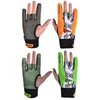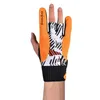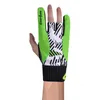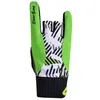Bowl with Confidence: The Ultimate Guide to Enhanced Control with Bowling Gloves
Bowling gloves are essential for a comfortable and efficient bowling experience. They offer improved grip, reduced friction, and better wrist support compared to bare hands. There are various types of bowling gloves available in the market, including fingerless gloves, full-finger gloves, and wrist supports, each with its unique features and benefits. When choosing the right bowling gloves, it is crucial to consider factors such as sizing, material, and design, depending on individual needs and preferences. Proper usage and care of bowling gloves can significantly impact their longevity and effectiveness. This article provides guidelines for wearing and using bowling gloves correctly and tips on how to clean and maintain them.






Benefits of Using Bowling Gloves
One of the primary advantages of using bowling gloves is the improved grip they provide. The textured palm surface of the glove allows for a more secure hold on the ball, ensuring a consistent release and preventing it from slipping out of your hand prematurely. This enhanced grip can lead to more accurate throws and ultimately higher scores.
In addition to improved grip, bowling gloves also help reduce friction between the ball and the hand. When bowling without gloves, the repetitive motion of releasing the ball can cause friction that leads to blisters and calluses. Bowling gloves act as a protective barrier, minimizing the risk of hand injuries and allowing players to focus on their game without discomfort.
Furthermore, bowling gloves offer better wrist support, which is crucial for maintaining proper form and technique. The added stability provided by the glove helps prevent excessive wrist movement during the release, reducing the risk of strain or injury. This support not only enhances the player’s performance but also contributes to their long-term health and well-being.
When comparing the use of gloves versus bare hands when bowling, it becomes evident that gloves offer a clear advantage. While some bowlers may prefer the tactile sensation of feeling the ball directly in their hand, the benefits of using gloves far outweigh this preference. Not only do gloves provide a superior grip and reduce friction, but they also offer essential support for the wrist, which is crucial for preventing injuries and maintaining consistency in one’s game.
Types of Bowling Gloves
Fingerless Gloves
Fingerless gloves are probably the most common type of bowling gloves used by players. As the name suggests, fingerless gloves leave the fingers exposed while providing padding and protection to the palm and wrist areas. Fingerless gloves are ideal for those who prefer maximum flexibility and control over the ball. These gloves enable players to have an excellent grip on the ball, resulting in better accuracy and performance.
Full-Finger Gloves
Full-finger gloves provide complete coverage to the hand and fingers. Unlike fingerless gloves, they offer more protection against friction and impact. Full-finger gloves are suitable for those who want more cushioning and support for their hands. These gloves also help prevent blisters and calluses from forming on the fingers. They are particularly useful for bowlers who bowl at high speeds or those who play frequently.
Wrist Supports
Wrist supports are designed to provide additional support to the wrist area. They can be worn alone or in combination with either full-finger or fingerless gloves. Wrist supports help stabilize the wrist during the release, resulting in improved accuracy and reduced chance of injury. They are especially helpful for bowlers who suffer from wrist pain or have weak wrists.
Features and Benefits
Different types of bowling gloves offer different features and benefits to players. Fingerless gloves offer maximum flexibility and control, allowing players to have a better grip on the ball. Full-finger gloves provide more cushioning and protection, preventing blisters and calluses from forming. Wrist supports offer extra support to the wrist area, helping stabilize the wrist during the release.
Most bowling gloves are made of synthetic materials such as polyester, nylon, and spandex. These materials are lightweight, durable, and provide excellent grip and flexibility. Some gloves also feature padded palms, adjustable wrist straps, and ventilation holes for added comfort and convenience.
Factors to Consider When Choosing Bowling Gloves
The first and foremost factor to consider when choosing bowling gloves is the sizing. Ill-fitting gloves can cause discomfort and hinder performance on the lanes. It is crucial to measure the hand size accurately and refer to the manufacturer’s sizing chart to find the perfect fit. Additionally, some gloves come with adjustable straps or wrist support, which can further enhance the fit and comfort level.
The material of the bowling gloves is another crucial factor to consider. Most bowling gloves are made from either leather or synthetic materials. Leather gloves are known for their durability and excellent grip, while synthetic gloves are often more breathable and lightweight. The choice of material depends on individual preferences and playing conditions. For instance, bowlers playing in hot and humid environments may prefer synthetic gloves for better ventilation.
Furthermore, the design of the bowling gloves plays a significant role in their performance and functionality. Some gloves come with reinforced fingers and palms for added durability, while others have specially designed grips or patterns to improve ball control. It is essential to assess the specific features of each glove and determine which design elements align with one’s playing style and needs.
When it comes to choosing the best bowling gloves for individual needs and preferences, there are several tips to keep in mind. Firstly, it is crucial to try on different gloves and assess their fit, comfort, and performance before making a purchase. Many pro shops and bowling equipment retailers offer the option to test out gloves before buying them.
Additionally, it is beneficial to seek recommendations from fellow bowlers or professionals who have experience with various glove brands and models. Their insights and feedback can provide valuable guidance in making an informed decision.
Another tip is to consider the specific playing conditions and environment. For example, bowlers competing in tournaments may require gloves with enhanced grip and support, while casual bowlers may prioritize comfort and breathability. It is essential to assess one’s playing frequency, style, and environment to determine the most suitable gloves.
How to Properly Use and Care for Bowling Gloves
Guidelines on how to wear and use bowling gloves correctly
When it comes to wearing bowling gloves, there are a few guidelines that you should follow to ensure maximum benefit from them. Firstly, it is important to choose the correct size. Bowling gloves come in different sizes, just like regular gloves. A glove that is too big or too small will not provide the right amount of support and could even hinder your gameplay. To determine the correct size, measure your hand according to the manufacturer’s instructions or try on different sizes until you find one that feels comfortable and snug.
Once you have the right size, it is important to wear the gloves correctly. Place your fingers into the finger holes and pull the glove up onto your hand, ensuring that it fits snugly around your wrist. Make sure that the glove is not twisted or bunched up, as this can cause discomfort and affect your grip on the ball.
During gameplay, make sure that you are using the gloves to their full potential. Grip the ball with your fingers and palm, using the textured material on the surface of the glove to create extra friction between the ball and your hand. Apply pressure evenly across the surface of the ball to achieve a smooth and consistent release.
Tips on how to clean and maintain gloves to ensure their longevity and effectiveness
Regular cleaning and maintenance of your bowling gloves is crucial to their longevity and effectiveness. Here are some tips on how to keep them in top condition:
1. Wash your gloves regularly – After every use, wash your gloves with mild soap and water. Gently scrub the surface of the glove, paying particular attention to any areas that are heavily soiled. Rinse thoroughly and allow to air dry.
2. Avoid harsh chemicals – Do not use bleach or other harsh chemicals when cleaning your gloves, as these can damage the fabric and reduce the effectiveness of the grips.
3. Store your gloves properly – After washing and drying, store your gloves in a cool, dry place away from direct sunlight. Avoid storing them in a damp environment, as this can cause mold and mildew to develop.
4. Replace gloves when necessary – Over time, the fabric and grips on your gloves will wear out. When this happens, it is time to replace them with a new pair.
In conclusion, proper use and care of bowling gloves is essential for maximizing their benefits. By following the guidelines on how to wear and use them correctly, and by taking steps to clean and maintain them, you can ensure that your gloves last for as long as possible and provide you with the support and comfort you need to excel at the sport of bowling.
FAQ
Q1. What are the benefits of using bowling gloves?
Bowling gloves provide enhanced control and grip, which can improve your overall performance on the lanes. The gloves are designed to absorb sweat and prevent the ball from slipping out of your hand, providing a more consistent release. Additionally, some bowlers may find that the gloves help to reduce hand fatigue or discomfort during extended play.
Q2. Are bowling gloves only for professional bowlers?
No, anyone can benefit from wearing bowling gloves. Whether you are a beginner or a seasoned pro, bowling gloves can help improve your game by providing better control and consistency. They are also helpful if you have conditions such as arthritis or carpal tunnel syndrome that make it difficult to grip the ball.
Q3. How do I choose the right bowling gloves for me?
When choosing bowling gloves, consider factors such as fit, material, and features. It’s important to select gloves that fit snugly but are not too tight, as this can affect your grip on the ball. Look for gloves made from durable materials such as leather or synthetic fabrics, and check for features such as adjustable wrist straps or extra padding in areas that experience the most wear and tear.
Q4. How do I care for my bowling gloves?
To prolong the life of your bowling gloves, it’s important to properly care for them. After each use, wipe the gloves with a clean damp cloth to remove any dirt or sweat. Avoid exposing the gloves to excessive heat or moisture, and never machine wash or dry them. If the gloves become excessively worn or damaged, it may be time to replace them to ensure optimal performance on the lanes.



